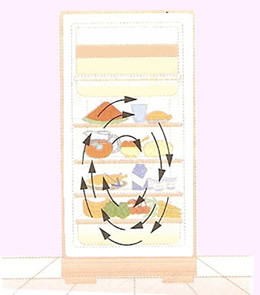The refrigerator is an important appliance used to cool food, its use began in the 18th century with the creation of the first versions. They consisted of a hole that was in a certain part of the house, and inside the hole was placed ice and straw over it, all to keep food. However, this refrigerator, like many of the inventions, only the rich could have. In the 19th century, the American Jacob Perkins registered the first machine capable of refrigerating food, however the poor still had no time to buy it, as the equipment was very expensive. In places where the heat was very intense, there was a great concern with the cooling of food, since the regions that were very cold did not have this concern, people left food outside the house buried under the snow.
With the evolution of technology, new refrigerators appeared, each time more powerful and more sophisticated. But how is food cooled inside the refrigerator? The cooling of food takes place through a heat transfer called convection. This is a form of heat transfer that occurs due to the differences between the densities of the hot and cold parts of the liquid or gas involved in the system, thus forming the currents of convection. This is the explanation for the cooling of food, the difference in density between warmer air and cooler air. What happens is that the cold air, being heavier, goes down cooling the food and the warmer air, coming from the food, being lighter, rises to be cooled, thus forming a cycle that is called convection currents, see illustration:
Do not stop now... There's more after the advertising ;)

Fridge
By Marco Aurélio da Silva
Brazil School Team
Thermology - Physics - Brazil School
Would you like to reference this text in a school or academic work? Look:
SANTOS, Marco Aurélio da Silva. "Food cooling in the refrigerator"; Brazil School. Available in: https://brasilescola.uol.com.br/fisica/resfriamento-dos-alimentos-na-geladeira.htm. Accessed on June 27, 2021.


